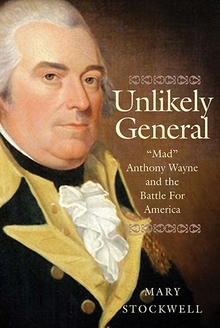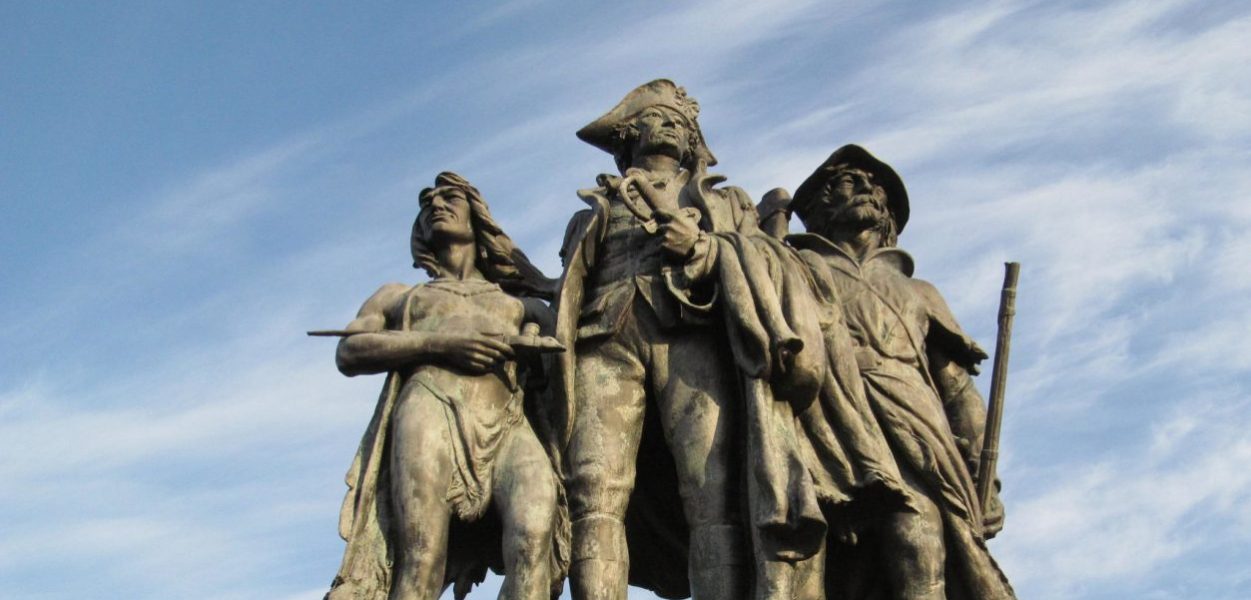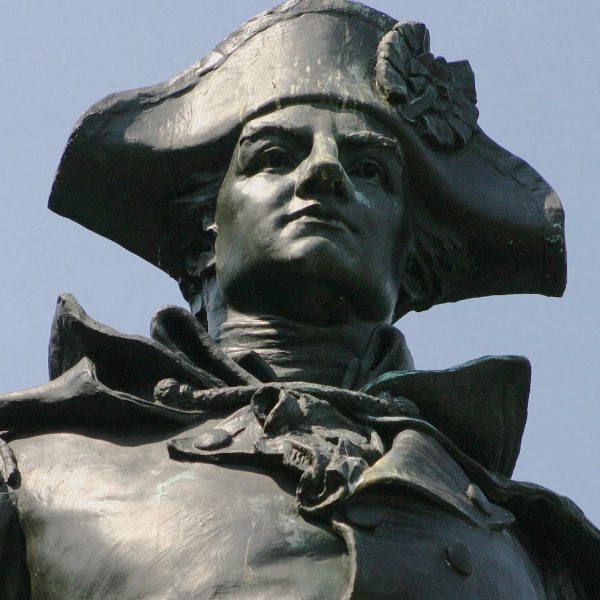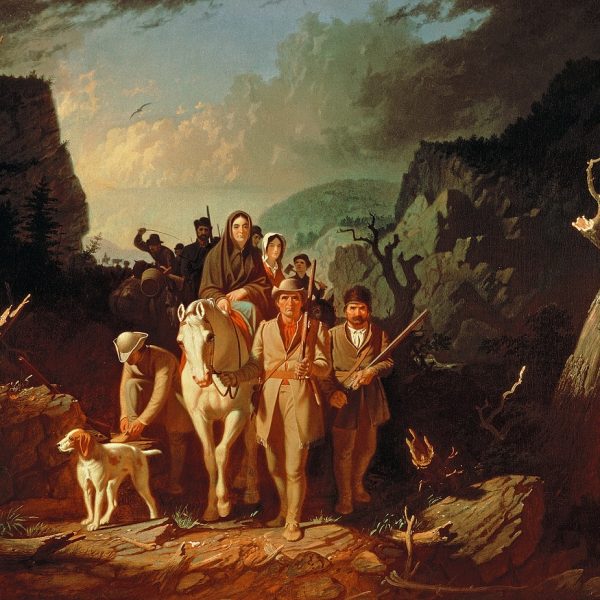The Legacy of Anthony Wayne
Mary Stockwell—
The statue of Anthony Wayne that looks out over the Maumee Rapids where he won his battle for America on the morning of August 20, 1794, is a beautiful one. It is a far more fitting tribute to him than the simple phrase that Captain Bissell pounded into his coffin with golden nails: “A.W. 15 Dec. 1796.” High on a pedestal, Wayne stands straight and tall, looking out past the floodplain toward the rising sun. On his right stands an Indian, probably representing one of his scouts, and to his left stands a frontiersman in buckskin, no doubt a Kentucky volunteer. But as beautiful as the statue might be, it bears little resemblance to the man sent west in 1792 to defeat the Shawnee, Delaware, Wyandot, Miami, and Ottawa and all the tribes who fought with them.
A more accurate portrait would show Wayne’s legs and arms wrapped in flannel bandages so he could bear the pain of gout and the lead ball he still carried in his leg from the Yorktown campaign. No Indian would be standing with him, as his Choctaw and Chickasaw scouts, seeing how sick he was on the way north from Fort Defiance, abandoned him. Nor would a Kentucky volunteer, representing the militia that he so disliked for their bloodthirstiness and cowardice, stand at his side. Instead he would be with the soldiers of his Legion whom he carefully trained to march and maneuver, to load and shoot their muskets, and above all else, not to be afraid. Wayne would surely be far happier with a veteran officer on his right and a young recruit on his left.
But even the greatest artist could not portray the struggle that Wayne endured to bring his army to this place. Within himself, he stared down the demons of illness, despair, and an acute anxiety for America’s future. Beyond himself, he faced a president and secretary of war who could not make up their minds for peace or war, a Congress that refused to feed and clothe the very army it had raised, and turbulent politics at home and abroad that painted Wayne as a fiend bent on destroying the very republic he had helped to create. Given the task of leading a third American army into the Ohio Country, probably to its own destruction, he had few experienced officers, recruits who ran at the mere thought of Indians, and a second in command who not only despised him, but who was working against him as a foreign agent.
Despite these obstacles, Wayne trained his veterans and recruits alike to become not just soldiers but an army. He was ever determined to feed, clothe, and supply his men who, like himself, were forgotten and alone in the vast wilderness they had all come west to secure. When after training his Legion for two years, and finally leading them toward the Maumee Rapids, where warriors waited to attack them with the full support of the British at their illegal post of Fort Miamis, he still doubted if they could ever win the battle that lay ahead, even though he had prepared them for so long to fight it. A year later, he was only convinced he had actually won the battle when the chiefs he had defeated drew their marks and totems on the treaty at Greeneville.
The very real struggles that Anthony Wayne endured have been largely forgotten. If people still remember him, they think of him as the confident man portrayed in the statue at Fallen Timbers rather than the hard-pressed commander who took years to ready his soldiers for the battle near the Maumee Rapids. Fearless, daring, even reckless, never believing he might lose, and above all else, “mad,” are words that come to mind when the name “Anthony Wayne” is mentioned. His trials during the Ohio campaign, and before that during the Revolution when he led a defeated army away from Three Rivers, played a pivotal role at Brandywine, Germantown, and Monmouth, foraged for the starving Continentals at Valley Forge and Bull’s Ferry, supported Lafayette in Virginia before the Yorktown victory, and took on any challenge necessary to defend Washington and America, the commander and nation he so loved, are all forgotten in that one word: “mad.”
Even if people recall the battles that he fought, few know that Wayne came to see war as a horrid trade of blood. From the moment his soldiers mutinied on New Year’s Day 1781, then continuing on through the desperate fight to save his men at Green Spring, and most terrible of all, during his forgotten command in the burning swamps and rice fields of Georgia, he lost his fascination with war and its glory that he had known since childhood. In his long descent through brutality, sickness, and despair, the dashing Wayne, who rarely receives more than a mention in history books about the Revolution, disappeared. The man who emerged in his place was more often than not sick and depressed, haunted by loneliness and the wrong choices he had made, and prone more to failure than success. He remained determined to defend America, whom he still loved as a woman, but he was more somber, more careful, and more aware of the dark uncertainties of this world. This man was the unlikely general that President Washington grudgingly chose to lead the Legion in one great battle against the Indians who were blocking the advance of the United States across the Ohio River.
Wayne never lived to see how his victory at the Battle of the Rapids, his name for the contest at Fallen Timbers, helped his country move west. He also never knew that he had bought his nation time, ten years to be exact, before the next generation of warriors living from the Appalachians to the Mississippi rose up, again with the help of the British, to halt the advancing Americans. The last man to flee from the battlefield near the Maumee Rapids, and who later refused to attend the negotiations at Greeneville, would lead a larger confederation against the United States than Bluejacket, Tarhe, and Buckongehelas had ever imagined. That man was the Shawnee warrior Tecumseh. In the War of 1812, he would fight to the finish against the young man with the green sash tied about him who rode with Wayne’s orders on that fateful day in August 1794: William Henry Harrison.
In the river valley where Wayne won his great battle for America, “mad” Anthony stands forever frozen in time.
From Unlikely General by Mary Stockwell. Published by Yale University Press in 2020. Reproduced with permission.
Mary Stockwell is the former chair of the history department at Lourdes University in Ohio and the author of The Other Trail of Tears: The Removal of the Ohio Indians.
Further Reading:


























